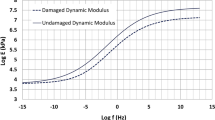Abstract
Pavement deflection has been used widely as a nondestructive technique to evaluate the structural capacity of pavements at both network and project levels. Current devices include Falling Weight Deflectometer (FWD) and the Deflectograph, which can record the deflection bowl shape. Utilizing these devices, a load is applied on the pavement surface and deflections at several lateral locations are recorded. Various transportation agencies use several evaluation methods to evaluate the integrity of the pavement layers. Most of these up-to-date developed indices are exclusively based on either central deflections or one deflection point along FWD deflection bowl. However, no standardized method is available that utilizes the full FWD deflection bowl.
This study aims to introduce new comprehensive pavement layer deflection and deflection bowl area parameters that are based on the entire FWD deflection bowl rather than one single deflection point and to relate the developed parameters to the field measured distress data. Required data for the study were extracted from the Long-Term Pavement Performance (LTPP) database.
Thirty-five different pavement sections in the State of Texas were utilized in the study. Four comprehensive deflection parameters were developed. In addition, a scale was developed that may be utilized for the overall pavement structural condition evaluation. The developed parameters as well as the scale were found to be well correlated to field performance of considered pavement sections. The newly developed parameters can also be easily implemented in pavement management databases (PMS) that would help state department of transportation (DOTs) in making more informed decisions about the most suitable maintenance strategy.
Similar content being viewed by others
References
G. R. Rada, S. Nazarian, J. Daleiden, T. Yu, Moving pavement deflection testing devices: State-of-the-technology and best uses, Paper ICMPA082, 8th International Conference on Managing Pavement Assets, Chile, 2011.
P. N. Schmalzer, Long-term pavement performance program manual for falling weight deflectometer measurements. No. FHWA-HRT-06-132. Federal Highway Administration. Office of Infrastructure Research and Development, United States, 2006.
R. Haas, W. R. Hudson, J. P. Zaniewski, Modern pavement management, Krieger Press, Malamar, Florida, 1994.
T. Scullion, Incorporating a Structural Strength Index into the Texas Pavement Evaluation System, Research Report 409 — 3F, Texas Transportation Institute, 1988.
D. S. Gedafa, M. Hossain, R. Miller, T. Van, Estimation of remaining service life of flexible pavements from surface deflections, J. Transp. Eng. 136 (4) (2010) 342–352.
O. Elbagalati, M. A. Elseifi, K. Gaspard, Z. Zhang, Prediction of In-Service Pavement Structural-Capacity Based on Traffic-Speed Deflection Measurements, J. Transp. Eng. 142 (11) (2016) 04016058.
M. Saleh, Simplified Approach for Structural Capacity Evaluation of Flexible Pavements at the Network Level, Inter. J. Pave. Eng. 17 (5) (2016) 440–448.
M. Saleh, Utilisation of the Deflectograph Data to Evaluate Pavement Structural Condition of the Highway Network, Road Mater. Pave. Des. 17 (1) (2016) 136–152.
M. Saleh, A mechanistic empirical approach for the evaluation of the structural capacity and remaining service life of flexible pavements at the network level, Canad. J. Civ. Eng. 43 (8) (2016) 749–758.
E. Horak, S. Emery, Falling Weight Deflectometer Bowl Parameters as Analysis Tool for Pavement Structural Evaluations, Proceedings, 22nd Australian Road Research Board (ARRB) International conference, Brisbane, Australia, 2006.
H. Yin, Simulation of flexible pavement response to FWD loads: A mechanistic approach, Inter. J. Pave. Res. Technol. 5 (4) (2012) 257–66.
J. S. Miller, W. Y. Bellinger, Distress Identification Manual for the LongTerm Pavement Performance Program. FHWA-HRT-13-092, USDOT, 2014.
Acknowledgements
The authors pay due credit and gratefully thanks US Department of Transportation (USDOT) and the Transportation Consortium of South-Central States (Tran-SET) for funding this research study.
Author information
Authors and Affiliations
Corresponding author
Additional information
Peer review under responsibility of Chinese Society of Pavement Engineering.
Rights and permissions
About this article
Cite this article
Loganathan, K., Isied, M.M., Coca, A.M. et al. Development of comprehensive deflection parameters to evaluate the structural capacity of flexible pavements at the network level. Int. J. Pavement Res. Technol. 12, 347–355 (2019). https://doi.org/10.1007/s42947-019-0041-0
Received:
Revised:
Accepted:
Published:
Issue Date:
DOI: https://doi.org/10.1007/s42947-019-0041-0




